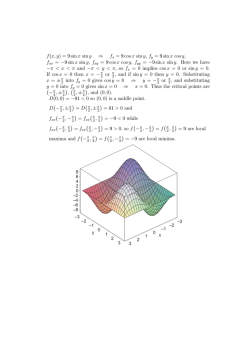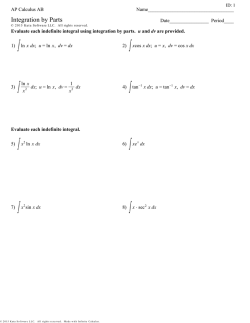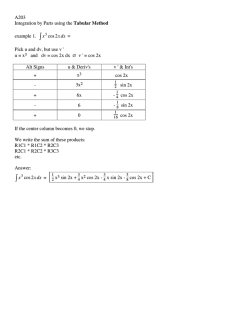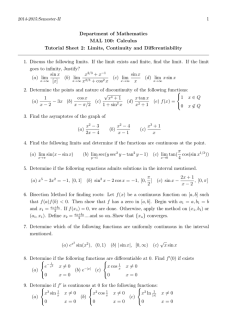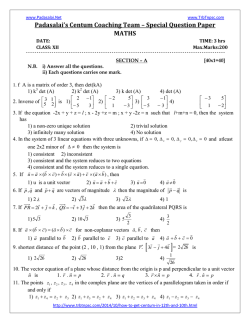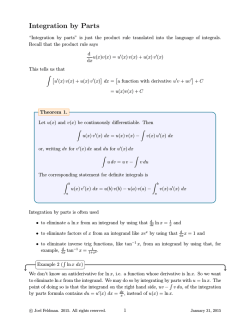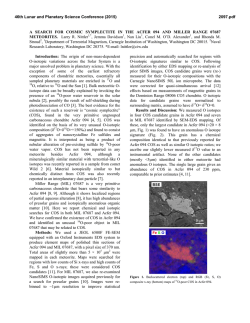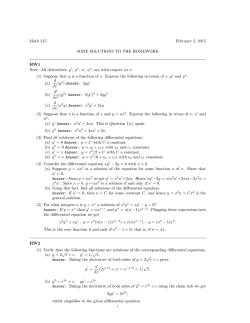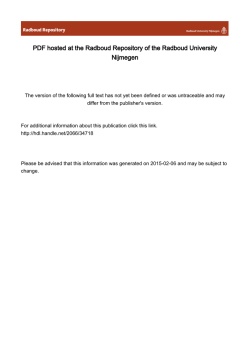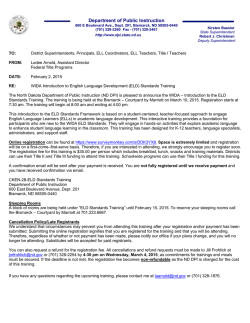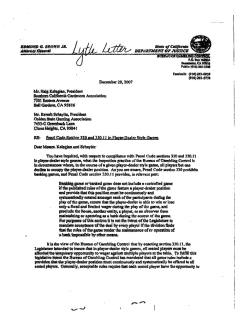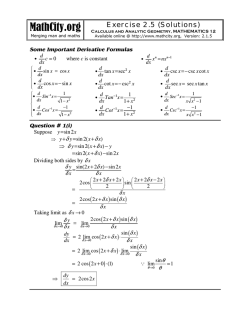
Exact solution of the Dirac equation for a Coulomb and a scalar Potential in the presence of an Aharonov-Bohm and a magnetic monopole elds Vctor M. Villalba Centre de Physique Theorique C.N.R.S. PostScript〉 processed by the SLAC/DESY Libraries on 8 Mar 1995. Luminy- Case 907-F-13288 Marseille Cedex 9, France Centro de Fsica, Instituto Venezolano de Investigaciones Cientcas IVIC, Apdo. 21827, Caracas 1020-A Venezuela Abstract In the present article we analyze the problem of a relativistic Dirac electron in the presence of a combination of a Coulomb eld, a 1=r scalar potential as well as a Dirac magnetic monopole and an Aharonov-Bohm potential. Using the algebraic method of separation of variables, the Dirac equation expressed in the local rotating diagonal gauge is completely separated in spherical coordinates, and exact solutions are obtained. We compute the energy spectrum and analyze how it depends on the intensity of the Aharonov-Bohm and the HEP-TH-9503051 magnetic monopole strengths. Typeset using REVTEX e-mail address: [email protected] 1 I. INTRODUCTION The Dirac equation is a system of four coupled partial dierential which describes the relativistic electron and other spin 1/2 particles. Despite the remarkable eort made during the last decades in order to nd exact solutions for the relativistic Dirac electron the amount of solvable congurations is relatively scarce, being the Coulomb problem perhaps the most representative example and also one of the most discussed and analyzed problems in relativistic quantum mechanics. Among the dierent approaches available in the literature for discussing the Dirac-Coulomb problem in the presence of other interactions like the Aharonov-Bohm eld or any other electromagnetic potential we have the quaternionic approach proposed by Hautot , the Stackel separation method developed by Bagrov et al , the algebraic method of separation of variables ; , the shift operator method , and the algebraic method proposed by Komarov and Romanova . Recently, Lee Van Hoang et al have solved the Dirac-Coulomb problem when an Aharanov-Bohm and a Dirac magnetic monopole elds are present. The authors use, for tackling the problem, a two dimensional complex space which results after applying the Kustaanheimo-Stiefel transformation on the three space variables, reducing in this way the Kepler problem to an oscillator problem. This idea lies on the utilization of a SU(2) dynamical algebra for computing the resulting energy spectrum , which, like the spinor solution, is expressed in terms of intrinsic coordinates appearing after using the complex space. The utilization of dierent techniques for studying the Dirac-Coulomb eld in the presence of an Aharonov-Bohm eld or a magnetic monopole could give rise to the idea that this problem is not soluble without introducing new variables or additional conserved quantities. Here it is shown that using the algebraic method of separation of variables it is possible to solve the Dirac equation in the presence of a Coulomb eld and a scalar 1/r potential with an Aharonov-Bohm and a magnetic monopole elds. The advantage of this approach is that does not require the introduction of non bijective quadratic transformations, also it becomes clear the role played by the Dirac magnetic monopole as well as the Aharonov-Bohm eld 1 2 34 5 6 7 8 9 2 in the angular dependence of the spinor (~r) solution of the Dirac equation. The article is structured as follows: In Sec. II, applying a pairwise scheme of separation, we separate variables in the Dirac equation expressed in the local rotating frame, we separate the radial dependence from the angular one. In Sec. III. the angular dependence is solved in terms of Jacobi Polynomials. In Sec IV, the separated radial equation is solved and the energy spectrum is computed. In Sec. V, we discuss the inuence of the Aharonov-Bohm eld and the magnetic monopole on the energy spectrum. II. SEPARATION OF VARIABLES In this section we proceed to separate variables in the Dirac equation when a Coulomb eld, a scalar 1/r potential as well as a Dirac magnetic monopole and a Aharonov-Bohm eld are present. For this purpose, we write in spherical coordinates the covariant generalization of the Dirac equation n o ~ (@ iA) + M + V~ (r) = 0 (1) where ~ are the curved gamma matrices satisfying the relation, f~ ; ~ g = 2g , and are the spin connections . with V~ (r) as the scalar 1/r eld + 10 0 V~ (r) = r (2) where 0 is a constant, and the vector potential A reads A = Amon + ACoul + AAB ( ) ( ) ( ) (3) where the components of the Coulomb potential ACoul take the form ( ) A Coul = V (r) = r ; AiCoul = 0; i = 1; 2; 3 ( 0 ) ( ) (4) the Aharonov Bohm potential AAB reads ( ) F e^ A AB = r sin #' ( ) 3 (5) and the Dirac monopole eld Amon is ( ) cos #) e^ A mon = g (1 r sin # ' ( (6) ) where, following the Dirac prescription for quantizing the magnetic charge, g takes integer or half integer values 11 g = 2j ; j = 0; 1; 2:::: (7) If we choose to work in the xed Cartesian gauge, the spinor connections are zero and the ~ matrices take the form h i ~ = = ; ~ = ( cos ' + sin ') sin # + cos # = ; h i ~ = 1r ( cos ' + sin ') cos # sin # = r ; (8) 1 ( sin ' + cos ') = ~ = r sin # r sin # where are the standard Minkowski gamma matrices, and the Dirac equation in the xed Cartesian tetrad frame (8) takes the form ( ) (@t + iV (r)) + @r + r @# + r sin # (@' iF i(1 cos #)g) + M +V~ (r) Cart = 0 0 0 0 2 1 1 1 2 2 3 0 1 2 3 1 2 1 3 3 2 3 (9) where we have introduced the spinor Cart, solution of the Dirac equation (9) in the xed tetrad gauge. In order to separate variables in the Dirac equation, we are going to work in the diagonal tetrad gauge where the gamma matrices ~d take the form 1 ~d = ; ~d = ; ~d = 1r ; ~d = r sin # 0 0 1 1 2 2 3 3 (10) Since the curvilinear matrices ~ and ~d satisfy the same anticommutation relations, they are related by a similarity transformation, unique up to a factor. In the present case we choose this factor in order to eliminate the spin connections in the resulting Dirac equation. The transformation S can be written as 12 4 S = r(sin1#) = exp( '2 ) exp( #2 )a = S a 1 2 3 1 where a is a constant non singular matrix given by, a = ( applied on the gamma's acts as follows 1 2 (11) 0 1 2 1 + + I ) which 2 1 3 2 a a = ; a a = ; a a = ; 1 1 3 2 1 1 3 1 3 (12) 2 the transformation S acts on the curvilinear ~ matrices, reducing them to the rotating diagonal gauge as follows S ~S = g = ~d (no summation) (13) 1 then, the Dirac equation in spherical coordinates, with the radial potential V (r), in the local rotating frame reads ) ( (@t + iV (r)) + @r + + r @# + r sin # (@' iF i(1 cos #)g) + M + V~ (r) rot = 0 (14) 0 3 2 1 where we have introduced the spinor rot, related to Cart by the expression Cart = S rot = S arot (15) 0 and are the standard Dirac at matrices. Applying the algebraic method of separation of variables ; , it is possible to write eq. (14) as a sum of two rst order linear dierential operators K^ , K^ satisfying the relation h^ ^ i n^ ^ o K ; K = 0; K +K =0 (16) 34 1 1 2 1 2 2 K^ = k = K^ 2 (17) 1 then, if we separate the time and radial dependence from the angular one, we obtain " # ^ K = i @# + sin # (@' iF i(1 cos #)g) = k (18) 2 2 3 0 5 1 h i K^ = ir @t + @r + M + i V (r) + V~ (r) = k (19) rot = (20) 0 1 1 0 0 1 with 0 1 where the operator K^ as well as K^ have been chosen to be Hermitean, therefore the constant of separation k appearing in (18) and (19) is real. Notice that if we drop out the Aharonov-Bohm and the magnetic charge contributions in eq. (18) we obtain the Brill and Wheeler angular momentum K^ , and separation constant k takes integer values. Now we proceed to decouple the equation (18) governing the angular dependence of the Dirac spinor In order to simplify the resulting equations, we choose to work with the auxiliary spinor related to as follows 1 2 10 = a (21) Since the operators K^ and K^ commute with the projection of the angular momentum i@, with eigenvalues m, we have that equation (18) takes the form " # (22) @# i sin # (m + F + (1 cos #)gt) = ik In order to reduce the equation (22) to a system of ordinary dierential equations, we choose to work in the following representation for the gamma matrices, 0 1 0 1 i B 0 CC B i 0 CC i = B (23) @ i A ; = B@ A; 0 0 i Then, substituting (23) into (22) we obtain, # " @# i sin # (m + F + (1 cos #)g) = ik (24) " # @# + i sin # (m + F + (1 cos #)g) = ik (25) 2 1 2 1 0 3 13 0 1 2 1 2 with 1 1 2 0 = eim B B@ 1 2 6 1 CC A 2 (26) III. SOLUTION OF THE ANGULAR EQUATIONS In this section we are going to solve the systems of equations (24) and (25). It is not dicult to see that the spinor can be written as G(r; t) , where G(r; t) is an arbitrary function, this property allows us to consider only the system (24). Using the standard Pauli matrices , we have that (24) reduces to 3 2 1 (m F (1 cos #)g) + sin # d d# = 0 (27) k sin # + (m F (1 cos #)) + sin # d d# = 0 (28) k sin # 1 2 2 with 1 0 B = Qeim B @ 1 1 2 2 1 1 CC A (29) where Q is a function depending on the variables t, r, to be determined after a complete separation of variables. In order to solve the coupled system of equations (27)-(28) we make the following ansatz, = (sin #2 )a(cos #2 )bf (#); = (sin #2 )c(cos #2 )dq(#) 2 1 (30) where a, b, c, and d are constants to be xed in order to obtain solutions of the governing equations for f (#) and q(#) in terms of orthogonal special functions. Substituting (30) into (27) and (28) we obtain, (x) = 0 kq(x) ( m2 F2 + a2 + 12 )f (x) + (1 x) dfdx (31) kf (x) + ( d2 g m2 F2 )q(x) + (1 + x) dqdx(x) = 0 (32) where we have made the change of variable x = cos #; and we have simplied the resulting equations (31) and (32) by imposing c = m F; and b = m F 2g: If we set a = m F +1; and d = m F + 1 2g;and make the change of variables u = (1 x)=2, we obtain that the coupled system of equations (31)-(32) takes the form 7 (u) = 0 kq(u) (m F + 12 )f (u) u dfdu kf (u) + (m F 2g + 12 )q(u) + (u 1) dqdu(u) = 0 (33) (34) from (33) and (34) we obtain q(u) + [(m F + 1 ) 2(m F g + 1 )u] dq(u) + u(1 u) d du 2 2 du + [k (m F + 12 )(m F 2g + 21 )]q(u) = 0 f (u) + [(m F + 3 ) 2(m F g + 1)u] df (u) + u(1 u) d du 2 du + [k (m F + 12 )(m F 2g + 21 )]f (u) = 0 2 2 2 (35) 2 2 2 (36) the solution of the equation (35) can be expressed in terms of the hypergeometric function F (a; b; c; u) as follows 14 q(u) = c F (a; b; c; u) (37) 1 where c is a constant, and a; b; and c are 1 q k +g a = m F g + 21 2 q b = m F g + 12 + k + g 2 2 (38) 2 (39) c = m F + 12 (40) then, with the help of (34) and (37) we nd that f (u) reads f (u) = c m kF + F (a; b; c + 1; u) 1 1 2 Since we are looking for normalizable solutions according to the product Z 2 k yk d# = kk 2 0 0 8 0 (41) (42) we have that the series associated with the hypergeometric function F (a; b; c; u) should be truncated reducing it to polynomials. This one is possible if a = n or b = n in (37) where n is a no negative integer value. Then using the relation between the Jacobi Polynomials and the functions F (a; b; c; x) Pn; (x) = n(n! +(++1)1) F ( n; n + + + 1; + 1; 1 2 x ) we have that (41) and (37) reduce respectively to ( ) f (x) = c0Pnm ( q(x) = c0 g + F +1=2;m F 2g 1=2) (x) pk + g Pnm k 2 2 ( (43) (44) F 1=2;m F 2g+1=2) (x) (45) where c0 is a constant, and n reads q n = m + F + g 12 + k + g Then, the components and of the spinor (29) can be written as = c0(sin #2 )m F (cos #2 )m F g Pnm F = ;m F g = (cos #) 2 1 +1 2 pk + g # )m F (cos # )m (sin k 2 2 2 (46) 2 1 2 = c0 g + 2 2 ( +1 2 2 1 2) F 2g+1 P (m F 1=2;m F 2g+1=2) (cos #) n Notice that the orthogonality relation for the Jacobi Polynomials Z (1 x)(1 + x) Pn; (x)Pm; (x)dx = 2 (n + + 1) (n + + 1) 2n + + + 1 (n + 1) (n + + + 1) mn 1 ( ) ( (47) (48) ) 1 + +1 (49) imposes some restrictions on the values of m; F and g in (47) and (48) In fact, from (49) we have that > 1; > 1 and consequently we have that 15 m F + 21 > 0; m F 2g + 1=2 > 0 (50) aords the required condition of orthogonality. However, some values considered in the inequalities given by (50) fail in fullling a condition which should be also took into account 9 in selecting the possible values of m; F and g: : All the expectation values associated with the separating operators should exist. In fact, if we consider the operator K^ dened by the R R relation (18) we have that the integrals d# @# as well as d# @# should be nite. This one imposes some restrictions on m; F and g. Looking at the convergency when # ! 0; and # ! we obtain the relations 2 1 1 2 2 m F > 0; m F 2g > 0 (51) which are weaker than those given in (50) In order to be able to consider other relations among the parameters m; F and g dierent from (46) we are going to consider a second solution of the equation dierential equation (35) q(u) = u c (1 u)c 1 a b F (1 a; 1 b; 2 c; u) (52) then, using the recurrence relations for the hypergeometric functions, we nd that a solution for the system (33)-(34) reads f (u) = c u 2 = m+F (1 u) 1 2 a; 1 b; 21 m + F ; u) m+F +2g+1=2 F (1 (53) k = m F (1 u) m F g = F (1 a; 1 b; 3 m + F ; u) u m+F 2 where c is a constant. From (53) and (54) we obtain that and take the form q(u) = c 1 2 2 1 2 + 2 1 = c(sin #2 ) 1 2 m+F (cos # ) m+F +2g+1 P ( 1=2 m+F;2g m+F +1=2) (cos #) n 2 = c pk +kg g (sin #2 ) m F (cos #2 ) m F g Pn = m F; g m with c as a constant of normalization, and in the present case n is q n = m F g 12 + k + g 2 1 2 (54) + +2 +1 2 + + +2 (1 2 + 2 2 2 (55) F 1=2) (cos #) (56) + (57) 2 Following the same reasoning used for deriving (51), we have that the expressions for and given by (55) and (56) are valid when 1 2 10 m + F > 0; 2g m + F > 0 (58) A third possible solution of the equation (35) can be written as q(u) = (1 u)c a b F (c a; c b; c; u) (59) then, substituting (59) into (34) we nd that f (u) and q(u) take the form: q q f (u) = c (1 u) m F g = F (1 + g + k + g ; 1 + g k + g ; m F + 23 ; u) (60) 3 + +2 +1 2 2 q(u) = c m Fk + 1=2 (1 u) 2 m+F +2g 1=2 F (g + 3 2 2 q q k + g ; g k + g ; m F + 12 ; u) (61) 2 2 2 2 where c is a constant. Using the relation between the hypergeometric function F (a; b; c; x) and the Jacobi Polynomials Pn; (x) given by eq. (43) we arrive at 3 ( = c(sin #2 )m 1 ) F +1 (cos # ) m+F +2g+1 P (m F +1=2; m+F +2g+1=2) (cos #) n 2 = c n +k 1 (sin #2 )m F (cos #2 ) 2 m+F +2g P (m F 1=2; m+F +2g 1=2) (cos #) n+1 where c is a constant of normalization and n is given by q n= k +g g 2 (62) (63) (64) 2 In this case, we have to impose the following restrictions on the values of m; F and g: m F > 0; m + F + 2g > 0 (65) Finally, considering as solution of the equation (35) the expression q(u) = u cF (a c + 1; b c + 1; 2 c; u) 1 then, in the present case the functions f (u) and q(u) read q q f (u) = u = m F F ( g k + g ; g + k + g ; 12 m + F ; u) 1 2 + 2 2 11 2 2 (66) (67) q(u) = k = u m+F 1 2 1 2 m+F F ( = c (sin #2 ) 1 4 = c nk (sin #2 ) with n given by 2 4 1 g q q k + g + 1; g + k + g + 1; 23 m + F ; u) (68) 2 2 2 2 m+F (cos # )m F 2g P ( 1=2 m+F;1=2+m F 2g) (cos #) n 2 m+F (cos # )m F 2g+1 P (1=2 m+F; 1=2+m F 2g) (cos #) n 1 2 q n= k +g +g 2 2 (69) (70) (71) and c is a constant of normalization. The solutions (69) and (70) are well behaved according to the Dirac inner product as well as to the expectation value of the operator of angular momentum (18) if 4 m + F > 0; m F 2g > 0 then, we have that the results (64) and (71) can be gathered as follows q n= k +g jg j 2 2 (72) (73) when the condition on m, F and g F + g+ j g j> m > g j g j +F (74) is satised. Regarding the eigenvalues m of the projection of the angular momentum operator i@' we have that since the transformation (11), relating the Dirac spinors rot and Cart in the local (rotating) and the Cartesian tetrad frames transforms after a rotation as follows Sz (' + 2) = Sz (') (75) and the spinor Cart is single valued, then we obtain rot(' + 2) = rot(') and therefore m takes half integer values m = N + 21 ; N = 0; 1; 2::: 12 (76) (77) IV. SOLUTION OF THE RADIAL EQUATION Now, we are going to solve the system of equation (19), governing the radial dependence of the spinor rot solution of the Dirac equation. This equation can be written in the form, ! k @t + @r + (M + V~ (r)) i V (r) + i r = 0 (78) 3 0 0 3 3 Using the representation for the gamma matrices given by (23), and the fact that eq. (78) commutes with the energy operator @t with eigenvalues E , we obtain the following system of equations ! k (79) dr + r (E V (r) M V~ (r)) = 0 3 1 ! k dr + r 2 (E V (r) + M + V~ (r)) = 0 3 2 1 (80) From (24)-(25),(79)-(80) and the fact that the Dirac equation (14) commutes with i@ and i@t, we have that the spinor can be written as follows 0 1 BB A(r) CC BB CC A ( r ) B CC = c ei m' Et B (81) BB C BB c B (r) CCC @ A c B (r) 1 0 ( 2 ) 1 2 where c is a constant, and A(r) and B (r) satisfy the system of equations ! k dr + r A(r) (E V (r) V~ (r) M )B (r) = 0 ! k dr + r B (r) (E V (r) + V~ (r) + M )A(r) = 0 (82) (83) notice that in this way we have xed the values of the functions Q(r; t) = e iEtA(r), and G = B (r)=A(r) appearing during the process of separation of variables. Substituting into (82) and (83) the form of the scalar and the Coulomb potentials we get 13 ! d + k A(r) E M + 1 ( + 0) B (r) = 0 dr r r (84) ! k B (r) + E + M 1 ( 0) A(r) = 0 r r (85) A = E + M; B = M E; ^ = + 0; = 0 (86) d dr Introducing the notation and the new variable ; related to r as follows p = Dr = M p E r = ABr 2 2 (87) we have that the system of equations (84)-(85) reduces to ! ! d + k A(r) B + ^ B (r) = 0 d D ! d k B (r) + A d D ! ^ A(r) = 0 We shall look for solutions of the system (88)-(89) in the form of power series 1 X A() = e s a + =0 1 X s+ b =0 B () = e (88) (89) ; 16 17 (90) (91) Substituting (90)-(91) into (88)-(89) we nd (s + k)a 0 ^ b = 0 (92) (s k)b 0 ^ =0 a (93) 0 0 and Bb [(s + ) + k] a ^b + D 14 1 a = 0 1 (94) ^ + A a [(s + ) k] b a D From (92)-(93) it follows that p s= k + 0 2 2 b = 0 1 (95) 1 (96) 2 where we have dropped out (96) the negative root because we are looking for wavefunctions regular at the origin of coordinates. From (94)-(95) we have that 8 9 8s 9 s < = < A ^ a = A ^ [(s + ) k]= b [( s + ) + k ] (97) : ; B ; : B The series (90) and (91) will have a good behavior at innity if they terminate for a nite value N. Putting aN = bN = 0 in (94)-(95) with aN 6= 0 and bN 6= 0; we arrive at bN = A (98) aN D Substituting (98) into (97), and taking into account (86) we get +1 +1 p (s + N ) M E = E + 0M 2 (99) 2 where s is given by (96) Finally, we obtain the energy spectrum: 8 v ! u > 0 < 0 u t E = M > (s + N ) + (s + N ) + : 9 = (s + N ) > (100) ; [(s + N ) + ] > Here two particular cases could be considered: a) 0 = 0 which corresponds to the Coulomb potential. In this case the energy spectrum reduces to: " # = p E = M 1 + (s + N ) ; s= k (101) where the negative root has been dropped out because it is not compatible with the relation (99) A second possibility is given by b) = 0; which is the scalar V 0(r) = 0=r potential. In this case the energy spectrum takes the form " #= 0 p E = M 1 (s + N ) ; s = k + 0 (102) notice that in the present case states with negative energy are possible, here we do not have critical behavior like in the Coulomb case. 02 2 2 2 2 2 2 2 1 2 2 2 2 2 1 2 2 2 2 15 2 2 2 V. DISCUSSION OF THE RESULTS In this section we are going to discuss the inuence of the Aharonov-Bohm potential and the Dirac magnetic monopole charge on the energy spectrum. Here we have mention that the Aharonov-Bohm as well as the magnetic monopole contributions are present in the expression (100) via the factor s given by (96), since the explicit form of k depends on the relation among m; F and g: In fact, we have that when the inequalities (65) or (72) are valid, the expression for s takes the form q s = (n+ j g j) g + 0 (103) 2 2 2 2 and no contribution of the Aharonov Bohm potential is observed in (100). The values of m for which (103) takes place are given by the expression (74) It is worth mentioning that when the magnetic monopole contribution is absent, the inequalities given by the expression (74) never take place, and consequently, the expression for s given by eq. (103) is not applicable. In this case the energy spectrum can be computed by substituting the expression q s = (n+ j m F j +1=2) + 0 (104) 2 2 2 into (100). Analogously, the energy spectrum when F = 6 0 and g6= 0 can be obtained after substituting into (100) the following value of s q s = (n + m F g + 1=2) g + 0 (105) 2 2 2 2 when m F > 0 and m f 2g > 0: Otherwise, when m F < 0 and m F 2g < 0, the value of s to substitute into (100) reads q s = (n m + F + g + 1=2) g + 0 (106) 2 2 2 2 Perhaps the most interesting and puzzling result of the present paper is the non dependence of the energy spectrum on the Aharanov-Bohm potential for a range of values given by the inequality (74). Despite this phenomenon was already pointed by Hoang et al there are 7 16 some discrepancies between their results and those ones present in this paper. Basically the problems lie on the criteria for establishing the boundary conditions and the normalizability of the wave functions. It is worth mentioning that since the Aharonov-Bohm contribution F can take non integer values, then the parameters and in the Jacobi Polynomials Pn; (x) can be negative provided that > 1; and > 1: Obviously if the Aharonov Bohm potential is absent, from the results presented in Sec. 3 we have that 0 and 0 (or in the case when F is an integer). Hoang et al consider that and are always positive restricting in the way the range of validity of the solutions. A second point to remark is that we not only impose the normalizability of the wave functions but also the existence of the expectation value of the angular momentum operator, which is equivalent R to say that y K^ d#d' < 1; in this way we have to impose that the spinor components and presented in Sec. 3 should satisfy R ; @# ; < 1 . Regarding the assertion made in about the existence of quantum states forbidden for the Dirac particle in the presence of the Coulomb plus the Dirac monopole potentials, we have that the boundary conditions imposed on the wave function in the present article avoid such a anomalous behavior and consequently the spinor is well dened for any value of the parameters m; F and g: ( 1 ) 2 12 12 7 ACKNOWLEDGMENTS The author wishes to express his indebtedness to the Centre de Physique Theorique for the suitable conditions of work. Also the author wishes to acknowledge to the CONICIT of Venezuela and to the Fundacion Polar for nancial support. 17 REFERENCES 1 2 A. Hautot, J. Math. Phys. 14 2011 (1973) V. G. Bagrov and D. M. Gitman, Exact Solutions of Relativistic Wave Equations (Kluwer, Dordretch, 1990) 3 G. V. Shishkin and V. M. Villalba, J. Math. Phys. 30 2132 (1989) 4 G. V. Shishkin and V. M. Villalba, J. Math. Phys 33 2093 (1992) 5 6 7 O. L. de Lange, and R. E. Raab, Operator Methods in Quantum Mechanics (Clarendon Press, Oxford 1991) L. I. Komarov and T. S. Romanova, Izv. Acad. Nauk. BSSR 2 98 (1982) L. V. Hoang, L. X. L. I. Komarov, and T. S. Romanova J. Phys A: Math. Gen 25 6461 (1992) 8 P. Kustaanheimo, and E. Stiefel, J. Reine Angew. Math 218 204 (1965) 9 M. Kibler and T. Negadi, Phys. Lett A. 124 42 (1987) 10 D. Brill, and J. A. Wheeler, Rev. Mod. Phys. 29 465 (1957) 11 P. A. M. Dirac, Proc. Roy. Soc. London 133A 60 (1931) 12 G. V. Shishkin, V. M. Villalba, Vestn. Beloruss. Gos. Univ. 3 6 (1987) 13 14 15 J. M. Jauch and F. Rohrlich, The Theory of Photons and Electrons (Springer Verlag, New York, 1976) I. S. Gradshteyn and I. W. Ryzhik, Table of Integrals, Series and Products (Academic Press, New York, 1965) W. Magnus, F. Oberhettinger, and R. Soni, Formulas and Theorems for Special functions of Mathematical Physics (Springer, Berlin 1966) 18 16 G. V. Shishkin and V. M. Villalba, J. Math. Phys. 34 5037 (1993) 17 A. S. Davydov, Quantum Mechanics (Pergamon, Oxford, 1965) 19
© Copyright 2026
